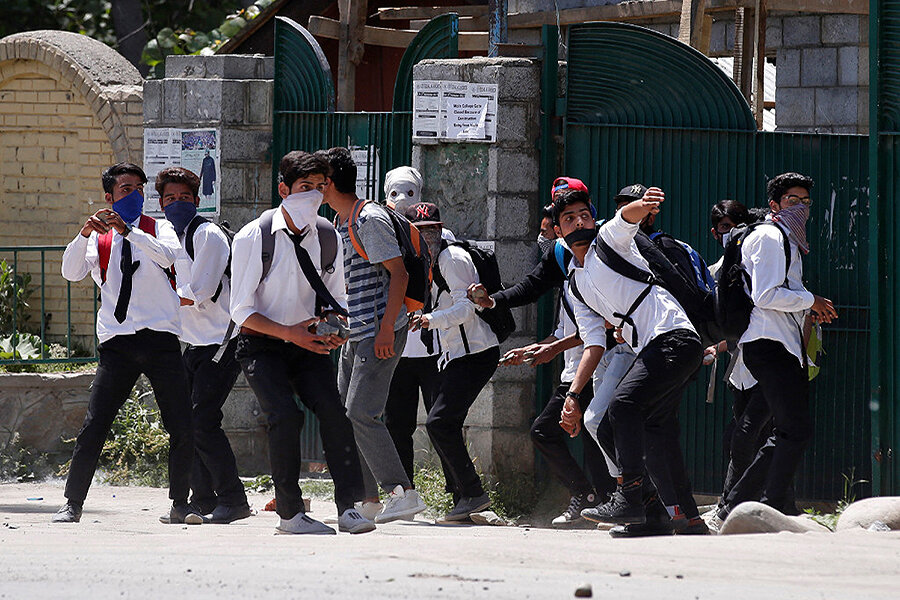With stones – and phones – Kashmiri youth show deepening resolve against India
Loading...
| Srinagar, Indian-controlled Kashmir
Talk to the young protesters in Indian-administered Kashmir today, and you will find more than the familiar slogans against India.
Young people are at the forefront of every protest, gathering in the hundreds and thousands to shout against Indian rule and throw stones at the soldiers. Streets are dotted with anti-Indian graffiti, much of it then defaced by soldiers. When news of a gunfight between soldiers and rebels breaks out, the young protesters race to the scene, hoping diversions will let the militants slip away – and that the videos they'll later post online can garner wider attention for Kashmir. Many assert they have no fear of death, if that's what it comes to.
It’s a gloomy illustration of many civilians’ increasing support for insurgents – a challenge for India, whose harsh attempts to quell unrest seem to only feed more anger and protests. But for soldiers, protesters, and bystanders alike, the cycles of unrest and repression can erase any semblance of normalcy, amid school closures, internet blackouts, and curfews.
Between January and April alone, at least 14 civilians at protests were fatally shot by soldiers, according to the Jammu Kashmir Coalition of Civil Society, a human rights group based in Srinagar. But many protesters, like 20-year-old Amir Zahoor, say deaths only reinforce their community's decades-old demand for “azadi” (freedom). In their eyes, India is an occupier.
“Our voice doesn’t reach the outside world; it only reaches because of stone-throwing or mujahideens [militants],” says Mr. Zahoor, who says he would join the rebels if needed.
There was a time when people would run away at the sound of gunshots, Zahoor argues. But now, more people come out of their homes, ready to protect the rebels, he says.
Few polls have been conducted in Kashmir, and one of the most comprehensive, from the UK-based Chatham House, dates back to May 2010, before a summer uprising that helped harden many Kashmiris' views against India. At that time, however, 43 percent of respondents in Indian-controlled Kashmir said they would vote for the whole of Kashmir to become independent, while 28 percent said they would vote to join India. Responses varied dramatically by division: in the Kashmir Valley, between 75 and 95 percent supported independence; in the Jammu Division, with a higher Hindu population, zero to 1 percent did.
Rekindled resistance
Conflict over Kashmir has existed since the Indian subcontinent won independence from Britain in 1947, and divided along into majority-Hindu India and majority-Muslim Pakistan. The Hindu prince of the Himalayan border region, which has a Muslim-majority population, wished to remain independent; eventually, he ceded his territory to India on the condition that Kashmiris would be given self-determination.
But India continues to claim the region, and no referendum has been held. A 350-mile line of control separates areas under Pakistan and Indian control: one of the most dangerous borders in the world, with rebels fighting for independence from India since the late 1980s.
After a summer of violence in 2010, tensions calmed. But the July 2016 killing of Burhan Wani, an iconic rebel commander, has again kicked popular sentiment against India into high gear. India's crackdowns – criticized by human rights groups for killing about 150 civilians last year, injuring more than 10,000, and imposing internet blackouts – have only served to strengthen the new generation’s resolve to broadcast their message, whether they hope to see the region join Pakistan or become independent. Anger surged again in late May, as hundreds of Kashmiris broke curfews to watch the funeral procession of Sabzar Ahmad Bhat, a rebel commander and successor of Mr. Wani, who was killed on May 27.
“If we had guns we would fight, but right now we have only got stones,” says Zahoor. “Almost every Kashmiri now knows that they are not just victims, but warriors.”
Although Zahoor mostly stays in his village, fearing arrest for throwing stones, he leaves to protest upon hearing about any fresh gunfight in adjoining areas. One of his cousins may pick up a gun and join the rebels, he says, which would make him the first in the family. Between 2013 and 2015, the number of local youth joining the rebels more than doubled; many of them were well-educated.
Projecting the message
Picking up guns to join the rebels or throwing stones on streets are not the only means of protest: the teens have smartphones, too, letting them bypass traditional media to tell their stories.
During a gunfight in March in Central Kashmir’s Chadoora area, three young men were killed. The first was Zahid Rashid Ganie – the only brother of five sisters. He had left home that morning after hearing gunshots, and started live-streaming the stone-throwing on Facebook. By 10 a.m., Rashid had posted several live videos in the paddy fields, before he was fatally shot.
Such stories are strengthening the resistance narrative in Kashmir, as pressure for a political solution grows. But progress is slow: the Indian government is holding out for two-party talks with Pakistan, while the tense atmosphere in the valley shrinks space for India-backed political parties, too, whose representatives find it difficult to return home.
On April 9, during parliamentary by-elections in central Kashmir, separatist leaders called for a boycott, and only 7 percent of registered voters went to the polls – the lowest in the past three decades. The next phase of elections in four districts was canceled, and eight civilians were killed by soldiers during anti-election protests, in which dozens of polling stations were attacked and voting machines burnt.
In the following days, many videos went viral. The clips included a teenage boy being shot from three yards away, several teenagers being beaten up, and a civilian tied to an Army jeep and driven through villages for hours as a human shield against stone-throwers. The Indian major accused of using the man as a shield was soon-after praised by several Indian politicians, despite an ongoing investigation, and awarded with a commendation card.
As the videos' views soared, the government’s response was to impose an internet blackout, banning almost two dozen 22 social networking sites, including Facebook and WhatsApp.
Even with internet restrictions, however, the government has found it difficult to stop people from coming out to support rebels. In one major gunfight last February in south Kashmir’s Frisal area, for example, four rebels, two soldiers, and two civilians were killed, while 25 others received bullet and pellet injuries.
Among those shot was Basit Ahmad Dar, who is 15. On hearing there was a gunfight, he had walked a few miles to reach on the spot and found boys, some younger than him, protesting.
“We were throwing stones for an hour or two, trying to save the militants,” before he was shot and taken to a hospital, Dar says, adding that it took two months to heal and walk properly. With a smile, he says that he's felt Kashmir was occupied since he was born. He took part in protests for the first time at age 13, during a gunfight in South Kashmir’s Redwani village, and remembers the 2010 mass uprising only vaguely.
“We have forgotten fear of death long ago,” says Dar, a ninth-grade student. “The war is on. My father didn’t say anything on seeing me that day, but parents in this village usually ask why didn’t you get martyred, rather than injured.”








